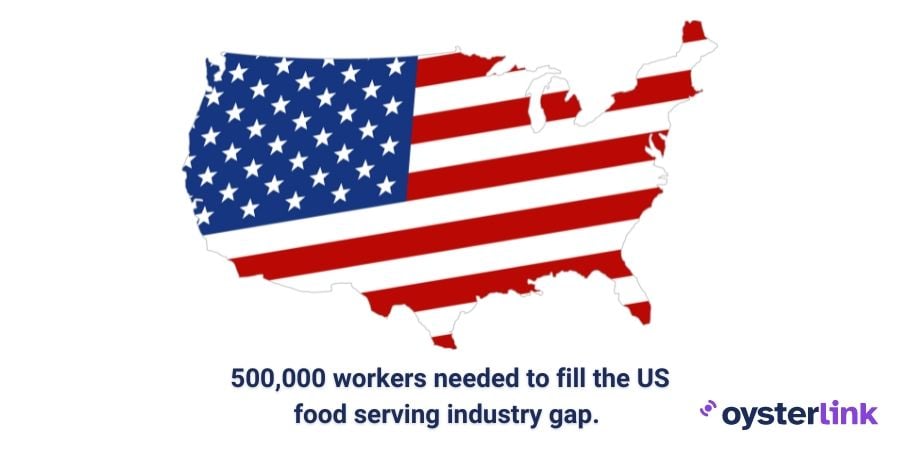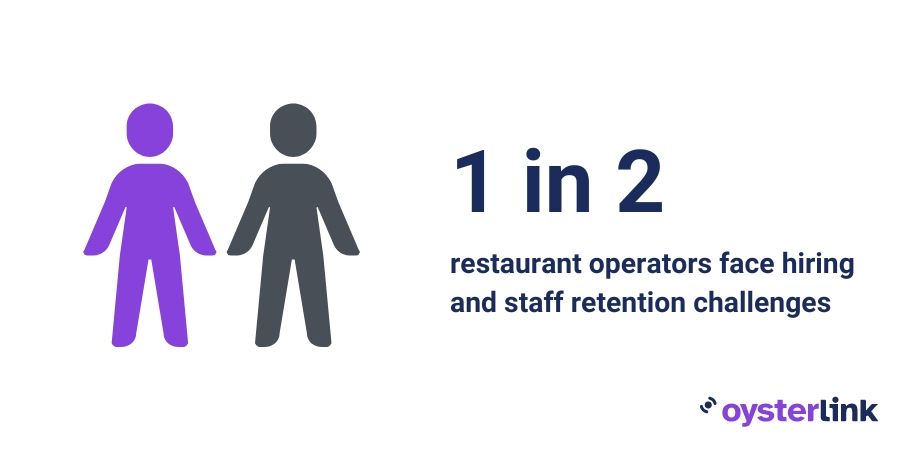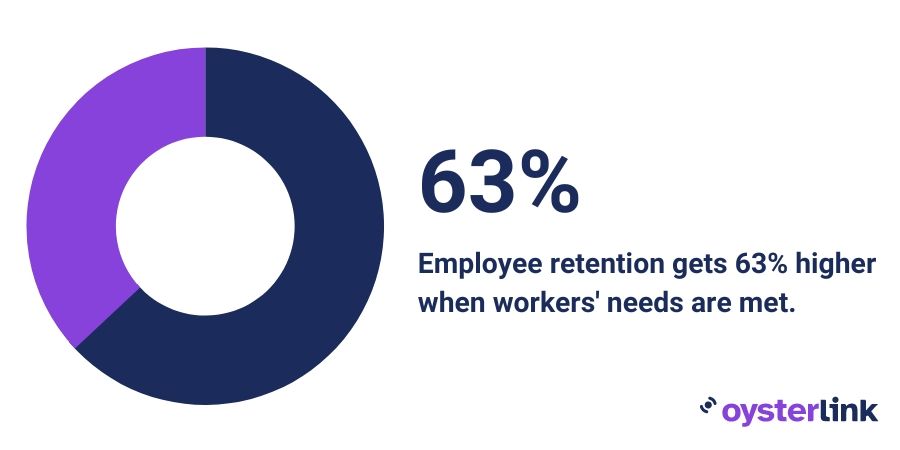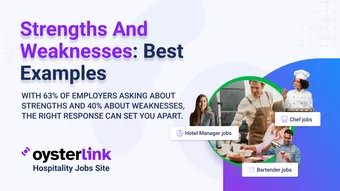Restaurant Staff Hiring: 3 Key Takeaways
- The restaurant industry needs an additional 500,000 employees to meet rising demand—roughly half the population of Montana.
- It takes an average of 27 days to hire the right candidate, costing restaurants up to $5,000 in lost time and revenue.
- Meeting employee needs leads to powerful results: 30% higher focus, nearly 50% more engagement, and 63% greater retention.
Restaurant staff hiring is no longer just about filling roles—it’s about building sustainable teams in one of the fastest-growing and most competitive industries.
With over 500,000 new workers needed to meet U.S. hospitality demand and 1 in 2 operators struggling to hire and retain staff, getting your recruitment strategy right is critical for success.
The State of Restaurant Recruitment and Hiring in the Industry
After an unprecedented dive in dining from 2019 and 2021, the restaurant worker has once again become one of the highest sought-after resources in the U.S.
Restaurant operators are also seeing more normal business conditions.
Now we’re witnessing record-breaking figures for the number of job openings in the hospitality industry.
To meet the overwhelming demand, the restaurant industry will need an additional 500,000 employees (about half the population of Montana!) to join its ranks.
With the economy recovering and people gradually regaining their confidence in dining out, the restaurant industry is poised for a huge resurgence.
This growth is driven by various factors, such as heightened consumer spending, a strong desire for socialization and the convenience of dining away from home.
However, this expansion brings with it the pressing need for more employees to meet the rising demand.

Navigating the labor shortage
The current labor shortage within the restaurant industry is a complex issue.
Several factors contribute to this challenge, including:
- Decline in available talent following the COVID-19 pandemic
- Changes in immigration policies affecting the workforce
- Shifts in job preferences among younger generations
COVID-19 alone caused more than 100,000 restaurants to shut down, leaving two-thirds of restaurant workers out of a job.
Once the restaurants started reopening—hiring once again became a daunting challenge for many establishments.
To bridge the gap, restaurant owners and managers are employing modern and creative strategies.
OysterLink is on a mission to provide a solution for all hiring managers and restaurant owners looking to hire local talent fast.
Innovative Recruitment and Retention Strategies
Innovative recruitment and retention strategies have become crucial for businesses that aim to create a more enticing work environment and more livable wages.
Upskilling and training programs
To address the shortage, many establishments are investing in comprehensive training programs to upskill existing employees and cultivate new talent.
By offering career advancement and skill development opportunities, restaurants can attract individuals seeking long-term stability and growth in the industry.
Flexible work arrangements
Recognizing the changing workforce expectations, many restaurants are adopting flexible work arrangements.
Part-time, freelance and remote work options are becoming more prevalent, appealing to individuals seeking work-life balance and diverse employment opportunities.
Enhancing employee benefits
To attract and retain talent, restaurants are prioritizing employee well-being by providing competitive benefits and cultivating positive work environments.
These initiatives include offering healthcare packages, paid leave, mental health support and fair compensation.
Developing a culture of inclusivity, diversity and respect also creates a welcoming atmosphere that encourages employees to thrive.
Streamline your restaurant recruiting process
Streamlining your restaurant recruiting process is critical to finding the right candidates quickly and efficiently.
On average, a restaurant owner will spend up to 27 days (about 4 weeks) to recruit the right talent, costing them up to $5,000 in revenue and time lost.
However, you can use OysterLink to connects with local talent in a matter of minutes.

Challenges in Hiring Restaurant Employees Today
Restaurant workers face several obstacles, from fast-paced environments to customer service dynamics, in their line of work.
Long and irregular hours
Restaurant workers frequently endure long and irregular hours, often including nights, weekends and holidays.
This can make it hard for them to have a consistent work-life balance. So, it’s always good practice to plan and schedule accordingly.
Physically demanding work
Working in a restaurant can be a challenge for the human body.
Employees may be required to stand for long periods, lift heavy objects and move quickly in a fast-paced environment.
This can lead to fatigue, muscle strain and other physical ailments.
High-stress environment
The restaurant industry is known for being dynamic and fast-paced.
Workers must handle time-sensitive orders, deal with demanding customers and work efficiently under pressure.
This constant stress can take a toll on employees’ mental and emotional well-being.
Low wages and income insecurity
Many restaurant workers, particularly those in entry-level positions, earn low wages.
Tips might be an added benefit, but tipped workers still face income variability and uncertainty.
This can make it challenging for workers to meet their financial obligations and achieve stability.
Following all the above reasons, one in two restaurant operators will experience difficulties hiring and maintaining their restaurant staff.

Who You’ll Find When You Hire Restaurant Staff
In restaurants, you’ll find a diverse workforce, including:
- Students and part-time workers
- Entry-level employees
- Career-oriented professionals
- Experienced industry veterans
- Immigrants and foreign restaurant workers
- Artists and creatives
- Career changers
In terms of average age, restaurant workers tend to be younger than the broader workforce.
For instance, the average age of a restaurant worker is 23 years old:
This diversity is further enriched by the significant representation of various ethnic groups.
Approximately 19% of restaurant workers identify as Hispanic or Latino and about 10% as Black or African American.
Such a multicultural workforce brings a variety of skills, enhancing the industry's ability to cater to a diverse customer base.
Tech Tools Powering Restaurant Recruitment and Staffing
The restaurant industry is rapidly embracing technology to improve efficiency and customer experience.
Automation and artificial intelligence (AI) are being integrated into various operations, from order taking to food preparation.
For example, some establishments are utilizing AI-driven kitchen equipment to maintain consistency and speed up service.
Also, digital payment systems and online reservation platforms have become standard, streamlining transactions and bookings.
Adopting these technologies not only enhances operational efficiency but also attracts a tech-savvy workforce interested in innovative work environments.
Meeting Employee Needs to Boost Staff Retention in Restaurants
Running restaurants in today’s competitive industry requires much more than just great food and ambiance.
A high standard of working conditions is essential for any reputable establishment looking to maintain its workforce.
One often overlooked but crucial aspect for employers is ensuring that your restaurant workers’ needs are met.
Recent research has shown that meeting employees’ needs can significantly impact their engagement, focus and overall satisfaction.
When employees perceive that their needs are being met, they exhibit remarkable benefits for both them and the organization.
Specifically, employees who feel their needs are met report a:
- 30% higher capacity to focus
- nearly 50% higher levels of engagement, and
- a 63% greater likelihood of staying with the company.
These statistics highlight the transformative power of catering to the needs of your restaurant workers.
And here are just a few basic needs that will motivate your restaurant workers to improve their performance and keep showing up at work.

Competitive compensation
Although cutting down on labor costs should always be a consideration, offering fair, even competitive, wages for your employees is equally important.
To advocate for this, huge groups of restaurant employees have taken a more proactive approach by unionizing.
This shift in industry makes this a more important factor than ever before.
Ensure that restaurant workers are fairly compensated for their work, taking into account market rates and the cost of living in your area.
Training and development
Investing in training and development programs can boost employee morale and the satisfaction of your average restaurant worker.
Provide opportunities for skill enhancement and career growth, such as workshops, seminars and cross-training opportunities.
Work-life balance
Recognize the importance of work-life balance for your employees.
Implement fair scheduling practices that take into account their personal needs and preferences.
By promoting a healthy work-life balance, you create a positive work environment that fosters employee loyalty and reduces turnover.
Supportive work culture
Create a supportive, inclusive work culture that values open communication, collaboration and employee feedback.
Encourage teamwork and recognize the contributions of your employees.
It’s best to seek their input regularly and, as much as possible, make everyone feel involved in decision-making processes.
Health and wellness
Prioritize your restaurant worker’s physical health and mental well-being.
Provide access to healthcare benefits, promote healthy eating options and encourage regular breaks to minimize burnout and job stress.
When all of the above is met, you might be surprised to see your average restaurant worker exceeding your expectations.










Loading comments...